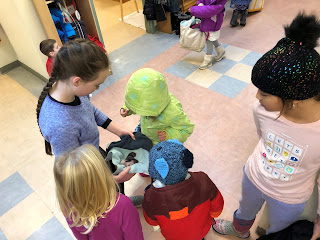Fall is officially here! The days are shorter
and it will be colder eventually. Time to bring the jackets and sweaters (labeled of
course so that we may return them when they land in the lost and found).
The classrooms are now in the process of what Montessori called 'normalizing'. The translation from Italian can be confusing, but what it means is that the children have become accustomed to the classroom routines, rules and work expectations, and are now learning and experiencing the characteristics that will make them successful learners: the love of work, self-discipline, concentration, and effective socialization.
This occurs through a three step process; first the preparation for work, the gathering of materials and the preparation of the mind to concentrate on the lesson or learning activity. Next is the deep concentration that comes from engagement and focus, and the third step is completion and rest, and the knowledge and satisfaction of a job well done.
For most children, this is a process that does not happen immediately, and each child has his or her own level of concentration and focus. Teachers help this process by providing activities and lessons to match the student's ability levels, as well as careful monitoring and observation of the environment and children's engagement. You will notice that we maintain a peaceful and calm atmosphere, and limit external stimuli. For example, there are not a lot of loud and distracting posters on the wall. There are also periods of the day when children experience 'false fatigue'. These are periods of time between work when children may not be engaged while they are deciding what they will work on next. Preserving their ability to make these decisions is very important in helping them to develop internal motivation and drive, which in turn helps them focus and concentrate on their work. One of the most satisfying moments of a teacher's day is when a child independently discovers a mathematical algorithm or pattern, or a science principle, as if he/she was the first person to discover it. Yes, you are likely to hear your child exclaim, "I learned it by myself!"
The classrooms are now in the process of what Montessori called 'normalizing'. The translation from Italian can be confusing, but what it means is that the children have become accustomed to the classroom routines, rules and work expectations, and are now learning and experiencing the characteristics that will make them successful learners: the love of work, self-discipline, concentration, and effective socialization.
This occurs through a three step process; first the preparation for work, the gathering of materials and the preparation of the mind to concentrate on the lesson or learning activity. Next is the deep concentration that comes from engagement and focus, and the third step is completion and rest, and the knowledge and satisfaction of a job well done.
For most children, this is a process that does not happen immediately, and each child has his or her own level of concentration and focus. Teachers help this process by providing activities and lessons to match the student's ability levels, as well as careful monitoring and observation of the environment and children's engagement. You will notice that we maintain a peaceful and calm atmosphere, and limit external stimuli. For example, there are not a lot of loud and distracting posters on the wall. There are also periods of the day when children experience 'false fatigue'. These are periods of time between work when children may not be engaged while they are deciding what they will work on next. Preserving their ability to make these decisions is very important in helping them to develop internal motivation and drive, which in turn helps them focus and concentrate on their work. One of the most satisfying moments of a teacher's day is when a child independently discovers a mathematical algorithm or pattern, or a science principle, as if he/she was the first person to discover it. Yes, you are likely to hear your child exclaim, "I learned it by myself!"


Comments
Post a Comment